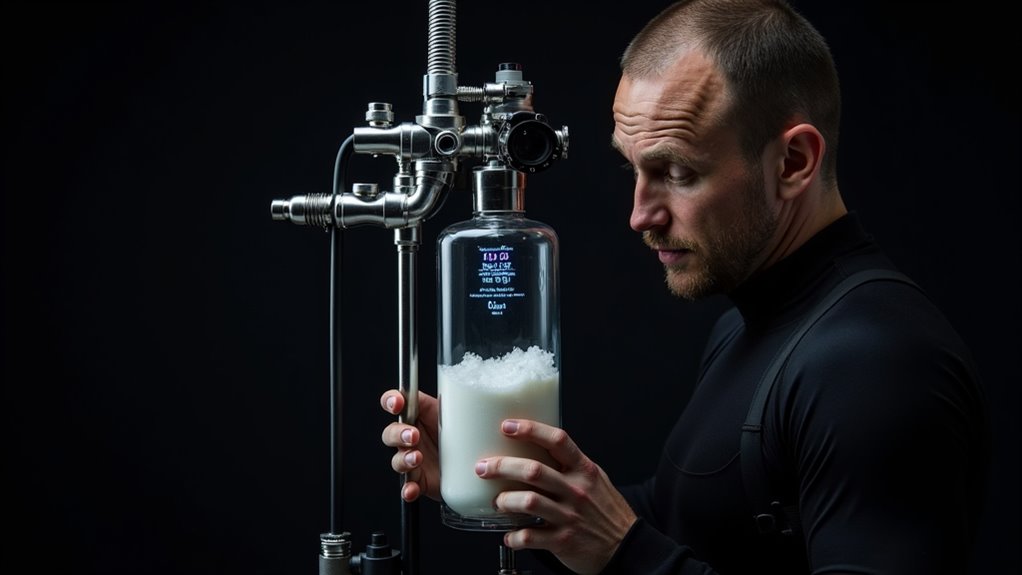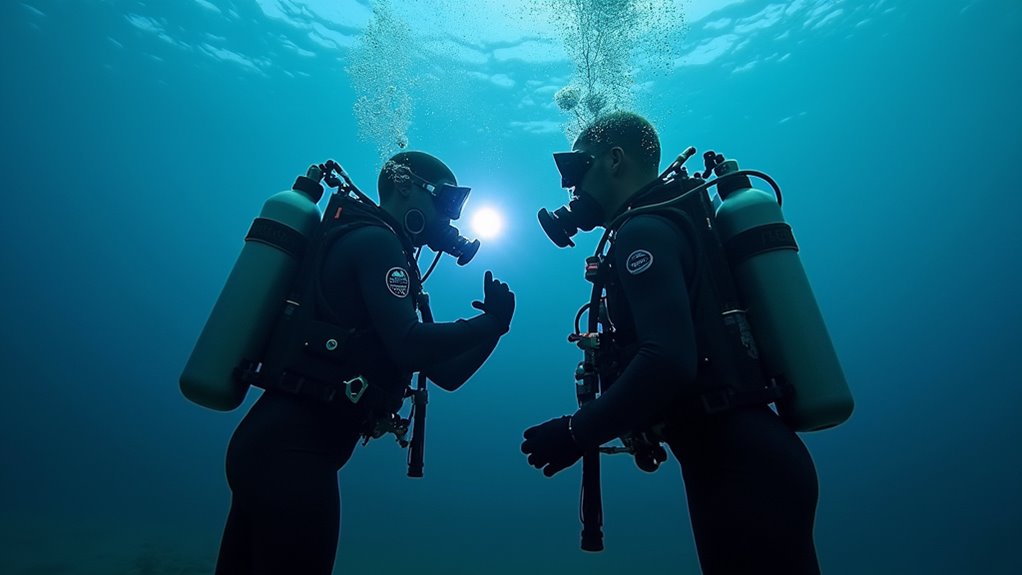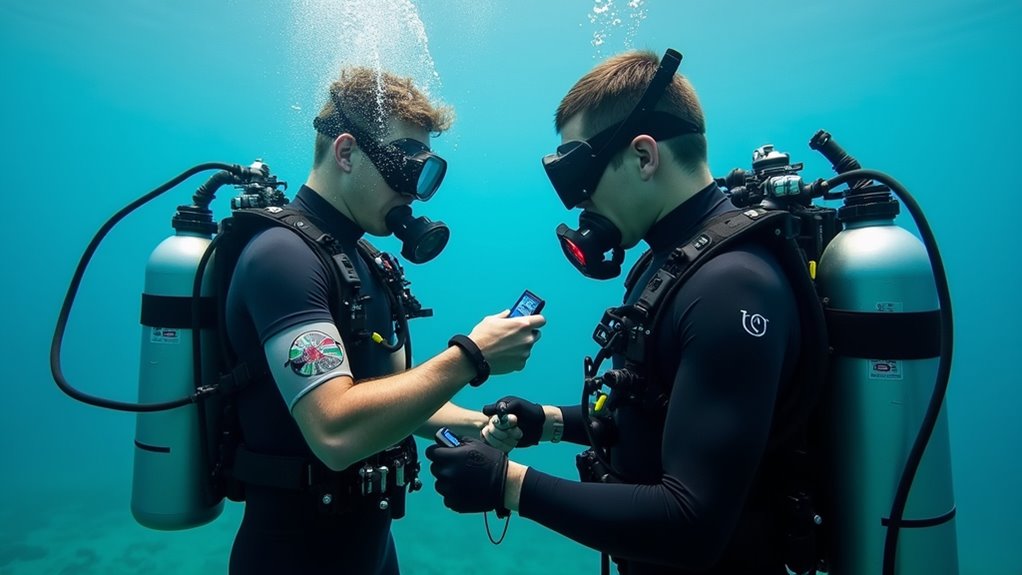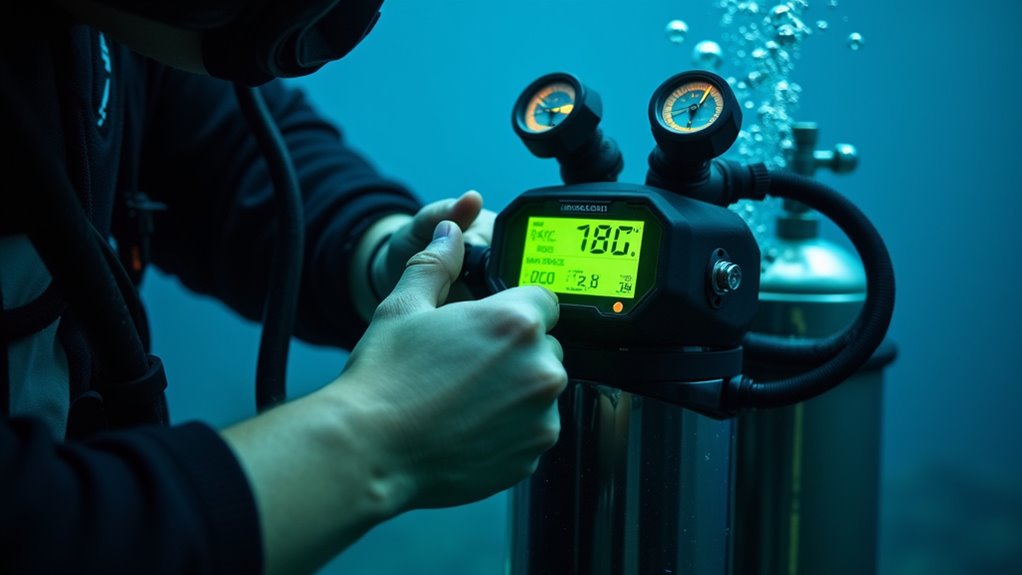Physical Address
304 North Cardinal St.
Dorchester Center, MA 02124
Physical Address
304 North Cardinal St.
Dorchester Center, MA 02124

A rebreather lets divers explore deeper and longer underwater while staying undetected, transforming how we experience the ocean's mysteries.
Like James Bond’s stealthy underwater missions, you’ll find rebreathers revolutionizing the way divers explore beneath the waves. Whether you’re conducting marine research, documenting underwater life, or maneuvering tight cave systems, these sophisticated breathing devices offer unique advantages you won’t get with traditional scuba gear. From their bubble-free operation to extended dive times, there’s a lot to uncover about how these remarkable systems are changing the game of underwater exploration.

While traditional scuba equipment releases exhaled breath directly into the water, rebreathers work by recycling your breathing gas through an intricate system of components.
You’ll find five main parts working together: a counterlung that acts as a flexible gas reservoir, a scrubber that removes CO2 from your exhaled breath, an oxygen supply system that replenishes fresh oxygen, breathing hoses that direct gas flow, and a mouthpiece or facemask that connects you to the circuit.
Each component plays an essential role in keeping you breathing safely underwater. The soda lime absorbent material in the scrubber efficiently removes carbon dioxide from your exhaled breath.
The counterlung expands and contracts as you breathe, while the scrubber uses chemical absorbents to clean your exhaled gas.
Inside a rebreather, your breath cycles through an expanding counterlung while chemical scrubbers filter the gas you exhale.
Oxygen sensors monitor gas levels, and valves control the flow throughout the system, ensuring you’re getting the right mix with every breath.
These basic components come together to make rebreathers a game-changer in marine research.
You’ll find that rebreathers greatly extend your bottom time underwater, letting you conduct longer surveys and collect more data without frequent decompression stops.
When you’re exploring cold environments like the Great Lakes or investigating complex marine habitats, you’ll appreciate how rebreathers reduce thermal stress and improve your mobility.
They’re particularly valuable in biological research, where you can study epibenthic communities with minimal disturbance to the environment since there are fewer gas bubbles released into the water. The TBNMS research team saw their daily productivity double their operations after implementing CCR diving mode between 2015 and 2017.
You’ll also benefit from the efficient gas usage, which means you won’t need to carry as many cylinders or make frequent gas changes.
This makes rebreathers ideal for research in remote locations or when you’re working in tight spaces like caves and shipwrecks.

Since military operations demand stealth and extended underwater capabilities, rebreathers have become essential equipment for special forces and technical diving units.
You’ll find advanced models like the MCM100 and Incursion BMR supporting diverse missions from explosive ordnance disposal to covert infiltrations. Developed through collaboration with the UK Defence Laboratory, the MCM100 represents cutting-edge military diving technology.
These systems offer you exceptional advantages over traditional scuba gear. You can operate silently without bubbles, making you virtually undetectable during sensitive operations.
The electronic controls precisely manage your gas mixtures while you’re working at various depths, and you’ll have integrated bailout systems for emergency situations.
When you’re conducting mine countermeasures or deep technical dives, you’ll appreciate how these rebreathers let you stay underwater longer while carrying less gas.
They’re also designed for instant deployment and minimal maintenance, keeping you mission-ready.
Photographers and filmmakers have discovered rebreathers to be game-changing tools for underwater imaging. When you’re shooting beneath the waves, you’ll appreciate the exceptional stability and bubble-free operation these devices provide. You won’t disturb marine life or create distracting bubbles in your shots, letting you capture natural behaviors up close. Silent gas circulation enables photographers to maintain better diving control and stability.
The ideal gas mixture control helps you stay comfortable and relaxed while shooting, which is vital for precise camera work.
You’ll find yourself able to plan more ambitious shots and spend more time perfecting your compositions underwater.

Modern rebreathers incorporate sophisticated safety features and monitoring systems that work together to keep you protected during dives. Your unit’s oxygen sensors continuously track PO2 levels, while electronic controls automatically adjust oxygen injection based on your depth and metabolism.
You’ll find multiple redundant alarms that warn you about unsafe oxygen levels before they become dangerous. The scrubber monitoring system lets you know when it’s time to replace your CO2 absorbent, while the automatic diluent valve maintains proper breathing loop volume as you change depths.
You’ll see all critical data displayed on your interface, including oxygen levels and scrubber time remaining. If anything goes wrong, you can quickly switch to your bailout system. The Juergensen Marines DIVA technology provides vibrating alerts to notify you of any system warnings. These integrated safety features work continuously to monitor your breathing gas and alert you to potential issues.
While traditional scuba systems have served divers well for decades, rebreathers offer several game-changing advantages that make them increasingly popular among serious divers.
You’ll find that rebreathers can transform your diving experience in remarkable ways, especially if you’re interested in technical diving or marine life observation.
The system’s ability to scrub CO2 from exhaled air allows divers to maintain optimal breathing conditions throughout their dive.
Here’s what you’ll get with a rebreather system:
These advantages make rebreathers particularly valuable for technical diving, underwater photography, and marine research applications.

One of the most impressive capabilities of rebreather systems is their ability to dramatically extend your time underwater.
According to divers surveyed, extended range rated 9.0 in importance as a key reason for using rebreathers.
You’ll be able to dive for 3-4 hours or even longer, compared to traditional scuba systems, thanks to the way rebreathers recycle your exhaled gas.
Your gas efficiency improves considerably because the system removes CO2 and replenishes oxygen in a closed loop, rather than releasing bubbles.
You’ll carry less gas while staying underwater longer, and you won’t need to change cylinders during complex dives.
The system maintains ideal oxygen levels throughout your dive, reducing your decompression requirements.
Because rebreathers produce minimal bubbles and operate quietly, they’ve revolutionized how divers interact with marine environments.
You’ll find that marine life is less disturbed by your presence, allowing for more natural observations and enhanced research opportunities.
While closed circuit rebreathers originated in the 17th century, their modern development has made them increasingly popular for marine observation.
Here’s what makes rebreathers environmentally superior:
These benefits make rebreathers an excellent choice for marine researchers, photographers, and conservation-minded divers who want to minimize their environmental impact while maximizing their underwater experience.
You’ve discovered how rebreathers transform your diving experience, offering you longer bottom times, quieter operations, and better marine life encounters. Whether you’re conducting research, performing military ops, or capturing underwater photographs, you’ll find these systems revolutionize your capabilities underwater. With proper training and monitoring, you’ll maximize your dive efficiency while minimizing your environmental impact, making rebreathers an invaluable tool for serious diving applications.